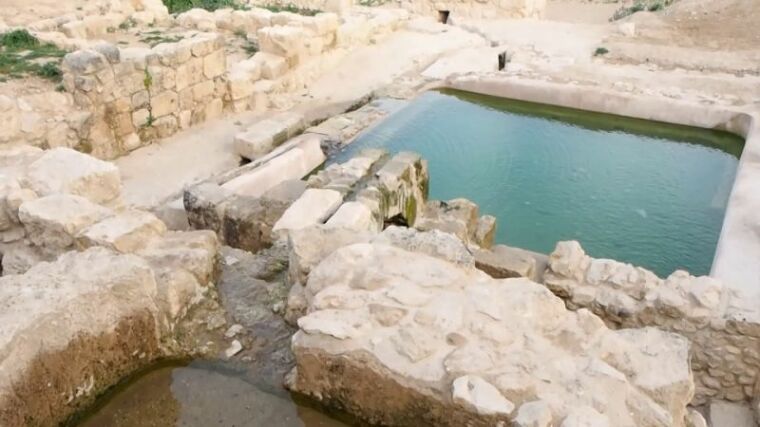Archaeologists uncover 1,500-year-old pool and fountain at Christian site in Israel

Israeli archaeologists have unearthed a large pool and an elaborate fountain that were said to be built around the fourth and sixth centuries A.D. at the site of an ancient church near Jerusalem.
The new discovery was part of a system of pools that were found at Ein Hanniya Park between 2012 and 2016, according to officials.
"The most significant finding in the excavation is a large and impressive pool from the Byzantine period," said Irina Zilberbod, the excavation director for the Israel Antiquities Authority, as reported by Fox News.
It is still unclear what exactly the pool was used for, but the scientists have speculated that it may have been a part of a royal estate built at the time of the First Temple era, which began some 3,000 years ago.
"It's difficult to know what the pool was used for -- whether for irrigation, washing, landscaping or perhaps as part of baptismal ceremonies at the site," Zilberbod said.
Jerusalem District Archaeologist Dr. Yuval Baruch noted that some Christian commentators have identified Ein Hanniya as the site where the Ethiopian eunuch was baptized by the apostle Philip, as described in Acts 8:26-40.
"The baptism of the eunuch by St. Philip was one of the key events in the spread of Christianity. Therefore, identifying the place where it occurred occupied scholars for many generations and became a common motif in Christian art," Baruch said.
Baruch further noted that part of the site is still the focus of religious ceremonies by the Armenian church, which owns the site, and the Ethiopian Church.
Zilberbod explained that the pool's water drained through a network of channels to a fountain, which the experts say is the first of its kind in Israel.
The experts worked to restore the water system so that the fountain, which is adorned with depictions of nymphs, is in working condition.
Other discoveries at the site include a silver coin from the fourth century B.C. and an ancient capital, or part of a pillar, that was said to be typical of royal structures found during the First Temple period. Coins, pottery and glass found at Ein Hanniya suggested that the site was a hub of activity between the fourth and sixth centuries B.C.
Ein Hanniya is just one of several archaeological sites in Israel that sheds light on early Christianity.
In 2017, a stunning 1,500-year-old Christian mosaic that was once the floor of a church or monastery was discovered in the ancient coastal city of Ashdod-Yam.
That same year, archaeologists found an ancient Greek inscription on a 1,500-year-old mosaic floor near the Damascus Gate in the Old City of Jerusalem. The inscription commemorates the founding of the building by a priest named Constantine and mentions emperor Justinian, who ruled in the sixth century A.D.
 Christians don't have to affirm transgenderism, but they can’t express that view at work: tribunal
Christians don't have to affirm transgenderism, but they can’t express that view at work: tribunal Archaeology discovery: Medieval Christian prayer beads found on Holy Island
Archaeology discovery: Medieval Christian prayer beads found on Holy Island Presbyterian Church in America votes to leave National Association of Evangelicals
Presbyterian Church in America votes to leave National Association of Evangelicals Over 50 killed in 'vile and satanic' attack at Nigerian church on Pentecost Sunday
Over 50 killed in 'vile and satanic' attack at Nigerian church on Pentecost Sunday Ukrainian Orthodox Church severs ties with Moscow over Patriarch Kirill's support for Putin's war
Ukrainian Orthodox Church severs ties with Moscow over Patriarch Kirill's support for Putin's war Islamic State kills 20 Nigerian Christians as revenge for US airstrike
Islamic State kills 20 Nigerian Christians as revenge for US airstrike Man who served 33 years in prison for murder leads inmates to Christ
Man who served 33 years in prison for murder leads inmates to Christ


 Nigerian student beaten to death, body burned over ‘blasphemous’ WhatsApp message
Nigerian student beaten to death, body burned over ‘blasphemous’ WhatsApp message 'A new low': World reacts after Hong Kong arrests 90-year-old Cardinal Joseph Zen
'A new low': World reacts after Hong Kong arrests 90-year-old Cardinal Joseph Zen Iran sentences Christian man to 10 years in prison for hosting house church worship gathering
Iran sentences Christian man to 10 years in prison for hosting house church worship gathering French Guyana: Pastor shot dead, church set on fire after meeting delegation of Evangelicals
French Guyana: Pastor shot dead, church set on fire after meeting delegation of Evangelicals ‘Talking Jesus’ report finds only 6% of UK adults identify as practicing Christians
‘Talking Jesus’ report finds only 6% of UK adults identify as practicing Christians Mission Eurasia ministry center blown up in Ukraine, hundreds of Bibles destroyed: 'God will provide'
Mission Eurasia ministry center blown up in Ukraine, hundreds of Bibles destroyed: 'God will provide' Church holds service for first time after ISIS desecrated it 8 years ago
Church holds service for first time after ISIS desecrated it 8 years ago Burger King apologizes for 'offensive campaign' using Jesus' words at the Last Supper
Burger King apologizes for 'offensive campaign' using Jesus' words at the Last Supper Uganda: Muslims abduct teacher, burn him inside mosque for praying in Christ’s name
Uganda: Muslims abduct teacher, burn him inside mosque for praying in Christ’s name